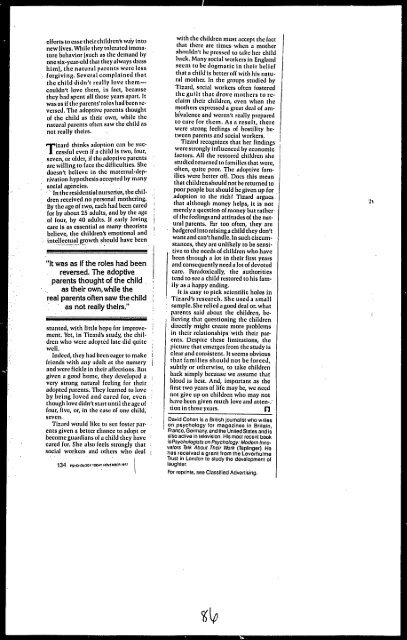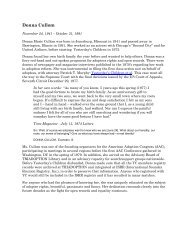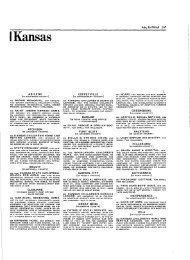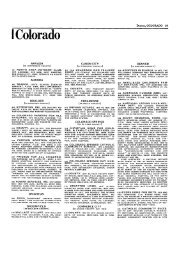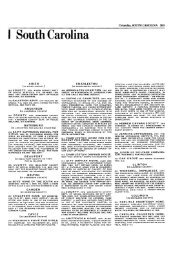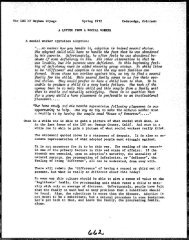Articles Book I - Pg 66-180 (1977) - triadoption
Articles Book I - Pg 66-180 (1977) - triadoption
Articles Book I - Pg 66-180 (1977) - triadoption
You also want an ePaper? Increase the reach of your titles
YUMPU automatically turns print PDFs into web optimized ePapers that Google loves.
efforts tocasetl~eircliildrenkwiy into<br />
new lives. While they tolerated imnlnture<br />
bcl~nvior [sucll as the demand by<br />
oncsix.ycar-olrl that tl~ey always dress<br />
him), the natural parents wcrc less<br />
,. forgiving. Several cotnplnined that<br />
thc child didn't renlly love themcouldn't<br />
lovc them, in fact, because<br />
they hadspent all those yearsapart. It<br />
wasas if thcpnrents'roles Iiadbcen re.<br />
versed. Tlic adoptive parents tl~ooglit<br />
of the child as thcir own, while the<br />
natural parents often snw the cliild as<br />
not really theirs.<br />
T<br />
izard thinks adoption can be successful<br />
even if a child is two, four,<br />
scven,or older, if the adoptive parents<br />
are willing to fscc tbcdifficultics. She<br />
doesn't hclievc in the maternal-dcprivation<br />
hypothesisncceptcd<br />
. .<br />
by many<br />
: social agencies.<br />
. ' 1n thcresidcntiolm~rseri~s, the cliildren<br />
rcceivcd no personal motheiing.<br />
By tlicngc of two, wch liad been cared<br />
for iiy al>out 25 adults, and by the age<br />
of four, by 40 adults. llcarly loving<br />
care isas essential as many theorists<br />
believe, d ~c children* cmotlonal and<br />
: intcllcctual ... growth .... should l~avc been<br />
. .<br />
"It was as if the roles had been<br />
reversed. The adoptive<br />
parents thought of the child<br />
. - as their own,whlle the<br />
real parents often saw the child<br />
: '<br />
as not really theirs."<br />
. .<br />
stunted, with littlc hope for lmprovcment.<br />
Yet, in Tizal.dk study, the cliildren<br />
who wcrc adopted late did quitc<br />
well.<br />
Indeed, they had hccn eager to make<br />
friends with any adult at the nurscry<br />
and wcre fickle in tlieir affccrioos. nut<br />
givcn n good home, they developed a<br />
very strong natural fecliiig for their<br />
adopted parents. They learned to love<br />
: by being loved and cared for, even<br />
tlioudi lovcdidn't sturt until tlicageof<br />
four, five, or, in the case of one child,<br />
seven.<br />
Tiznrd would like to see foster parents<br />
givcn a better chance to adopt or<br />
l~ccon~cgi~artlians of a cliild they have<br />
c~rerl for. She also fccls strongly that<br />
social<br />
.<br />
tvorkei and others who deal<br />
.<br />
!<br />
134 pa~umr toor? tmtusinelt<br />
\<br />
with the children must scccpt the fact<br />
th~lt there arc tinles when a motlier<br />
shnt~ldti't he pressed to tnkc licr cliild<br />
back. Many social workcrs in England<br />
seem to be dogmatic in tlicir belief<br />
that a child Is better off with lliv nntural<br />
motl~cr. In the groups studied by<br />
Tizard, social workers often fostered<br />
the guilt that drove mothers to re.<br />
claim tlieir children, even when the<br />
mothers expressed a great dcnl of anibi~nlencc<br />
and wercn't really prepared<br />
to carc fcrr tlie~n, As a result, there<br />
wcre Ytrong feelings of hostility between<br />
parents and social wcrrkcrs.<br />
Tizaril recog~lizcs that her findings<br />
tverestrongly i~dlucnced by economic<br />
factors. All the restored children she<br />
studicdreturncd to fn~tiilies that were,<br />
often, quite poor. The adoptive families<br />
were better off. Docs this mean<br />
that cliildrenshouldnot bereturned to<br />
poor people but should be givcn up for<br />
adoption to the rich? Tizard argues.<br />
that ultliough money helps, it is not<br />
merely n qucstion of money but rather.<br />
of thefeclin~snnd attitudesof the nnt.<br />
urn1 parents. hr too often, thcy are<br />
badgcrcdintoralsinga child they don't<br />
wantandcan't hondle.ln such clrcunistances,<br />
they arc unlikely to be scnsitive<br />
to the needs of eliildren who have<br />
been thtough a lot in their first years<br />
and consequently nccdn lot of devoted<br />
carc. I~radoxically, the autlioritics<br />
tend to see a cliild restored to his fnm.<br />
ily nsn happy ending.<br />
It is easy to pick scientific holes in<br />
Tizard's research. She used a small<br />
sample. She relied a good deal or. what<br />
' parents said about the children, hc-<br />
I licving that questioning the children<br />
directly might create more problems<br />
in their relationships 'with thcir parents.<br />
Despite these limitations, the<br />
picture that emerges from the study is<br />
clear and consistent. It sccrns obvious<br />
that families should not be forced,<br />
subtly or otherwise, to take children<br />
back simply because we assume that<br />
blood is best. And, important as the<br />
first two years of life may be; we need<br />
not give up on childrcil who may not<br />
11i1ve been given much lovc and atten-;<br />
tion in those years. n<br />
David ~ihon is a British journalisl wt~o writes<br />
on psychology tor magazines in Britain,<br />
Franco. Germany, and the UniledSlales and is<br />
also active in leievision. His most recent bwk<br />
isPsycholooists on Psyclrolo~y: Modern Inno.<br />
vators Talk About Tttolr Wrk (Taplinger). Ho<br />
tlos recolved a grant from the Leverhulrne<br />
Trust in London lo study tho dovelopmont ol<br />
lauglltor.<br />
For roprints, seo Clossllied Adverlising.


